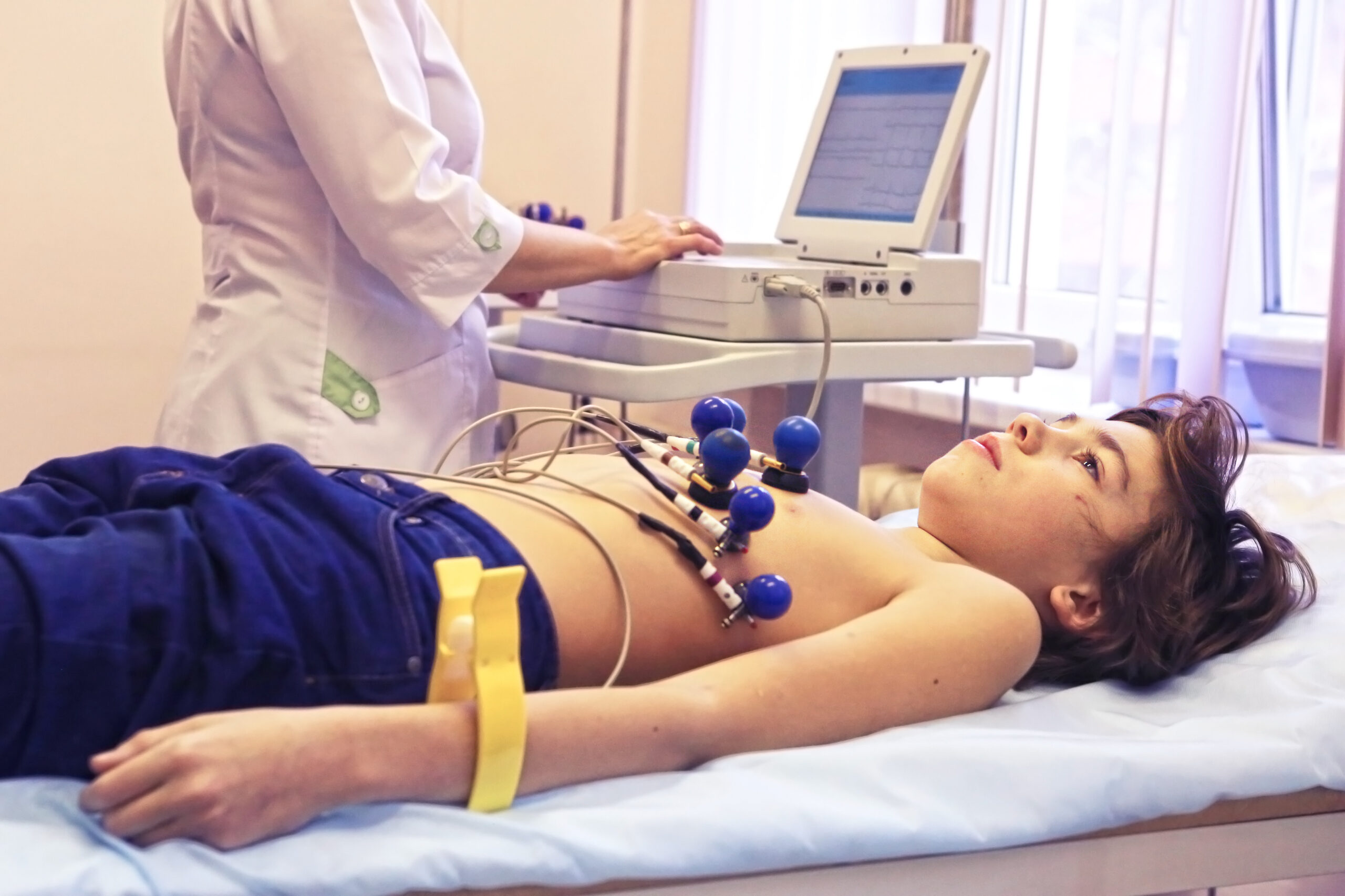Pediatric Tachycardia with a Pulse
Short Description
This algorithm outlines the steps to guide the provider to assess and manage a child with tachycardia with a pulse.
Algorithm at a Glance
- The provider identifies tachycardia and assesses the child to determine if the heart rate is appropriate for the child’s condition.
- If possible, the provider identifies and treats the cause of the tachycardia.
- Vagal maneuvers may be attempted if the child’s condition allows it.
- If the child is symptomatic, the provider considers the administration of sedation followed by synchronized cardioversion.
Goals for the Management of Pediatric Tachycardia
The provider must succeed in the following goals to successfully manage children with tachycardia:
- Identify the tachycardic rhythms, including:
- Sinus tachycardia
- Atrial fibrillation
- Atrial flutter
- Supraventricular tachycardia
- Wide complex tachycardia
- Identify symptomatic tachycardia with a pulse
- Appropriately treat the child with symptomatic tachycardia with a pulse
The Pediatric Tachycardia with a Pulse Algorithm
This algorithm outlines the steps for assessing and managing children presenting with tachycardia.
Pediatric Tachycardia With a Pulse Algorithm
Box 1: Assess the Child
The provider performs a quick assessment and does the following:
- Ensures patent airway
- Assists breathing as necessary
- Administers oxygen
- Provides a cardiac monitor to identify the rhythm
- Monitors blood pressure and oximetry
- Obtains IO/IV access but does not delay treatment
- Obtains a 12-lead ECG if available but does not delay therapy if unavailable
Related Video: Understanding the PALS Systematic Approach Algorithm
Box 2: Use a Monitor to Assess the Rhythm
Using a 12-lead ECG or monitor, the team evaluates the rhythm and classifies it as:
- Probable sinus tachycardia (the team proceeds to Box 3)
- Not sinus tachycardia (the team proceeds to Box 5)

A clinician administers an ECG to a child.
Related Video: One Quick Question: What are the Differences Between ST (sinus tachycardia) and SVT?
Box 3: Probable Sinus Tachycardia
Typically, this will be obvious by a history consistent with a known cause. In infants, the rate is usually < 220 bpm. In children, the rate is usually < 180 bpm. P waves are present, normal, and upright. The R-R may be variable, but the PR interval will be constant.

An ECG reading displays sinus tachycardia.
Box 4: Assess For and Treat the Cause of Sinus Tachycardia
Common causes of sinus tachycardia are activity, pain, fever, or other illnesses.
Box 5: Cardiopulmonary Compromise?
The provider assesses for cardiopulmonary compromise in the child. Signs are similar to those in an adult and include altered mentation, hypotension, and signs of shock. If the child has evidence of cardiopulmonary compromise, the team proceeds to Box 6; if not, the team proceeds to Box 11.
Box 6: Evaluate the QRS Duration
If the QRS is narrow (≤ 0.09 seconds), the team proceeds to Box 7.
If the QRS is wide (> 0.09 seconds), the team proceeds to Box 9.
Box 7: Probable Supraventricular Tachycardia (SVT)
The provider assesses the child and asks the parents about the onset of symptoms. The history of SVT usually indicates vague and nonspecific symptoms with sudden rate changes. In infants, the rate is often ≥ 220 bpm, and the rate in children is usually > 180 bpm. P waves are often abnormal or absent, and the heart rate is not variable.
Box 8: Treatment for SVT
If intravascular access is available, the team administers adenosine. The first dose is 0.1 mg/kg by rapid bolus (dose not to exceed 6 mg). This can be followed by a second dose of 0.2 mg/kg by rapid bolus (dose not to exceed 12 mg).
If IV/IO access is NOT available or adenosine is not effective, the team performs synchronized cardioversion.
Box 9: Possible VT
A wide QRS may indicate ventricular tachycardia with a pulse.
Box 10: Synchronized Cardioversion
If the child’s condition allows, the team can consider sedation, but definitive treatment should not be delayed.
The team immediately performs synchronized cardioversion with an initial energy dose of 0.5–1.0 J/kg. If this dose is not effective, the team increases the dose to 2 J/kg. The team calls for expert consultation.
Related Video: Synchronized Cardioversion for Tachycardia
Box 11: Evaluate the QRS Duration
If the QRS is narrow (≤ 0.09 seconds), the team proceeds to Box 12.
If the QRS is wide (> 0.09 seconds), the team proceeds to Box 15.
Box 12: Probable SVT
The provider assesses the child and asks the parents about the onset of symptoms. The history of SVT usually indicates vague and nonspecific symptoms with a history of sudden rate changes. In infants, the rate is often ≥ 220 bpm, and the rate in children is usually > 180 bpm. P waves are often abnormal or absent, and the heart rate is not variable.
Box 13: Consider Vagal Maneuvers
Since the child is not compromised, the team leader considers using vagal maneuvers to terminate the SVT.
Box 14: Administer Adenosine
If IV or IO access is available, the team administers adenosine. The first dose is 0.1 mg/kg by rapid bolus (dose not to exceed 6 mg). This can be followed by a second dose of 0.2 mg/kg by rapid bolus (dose not to exceed 12 mg).
Related Video: Adenosine – SVT Treatment
Related Video: Adenosine – ACLS Drugs
Box 15: Possible VT
A wide QRS may indicate ventricular tachycardia with a pulse.
Box 16: Consider Adenosine
If the rhythm is regular with monomorphic QRS complexes, the provider considers the administration of adenosine. The first dose is 0.1 mg/kg by rapid bolus (dose not to exceed 6 mg). This can be followed by a second dose of 0.2 mg/kg by rapid bolus (dose not to exceed 12 mg).
Box 17: Expert Consultation
The team now considers expert consultation.